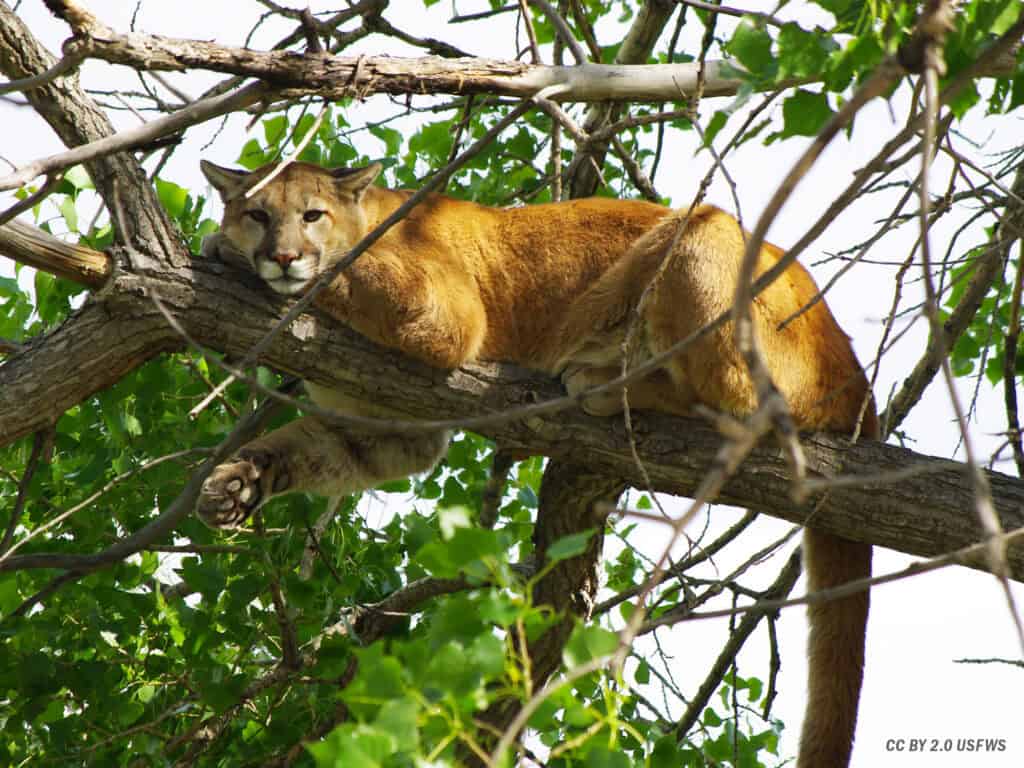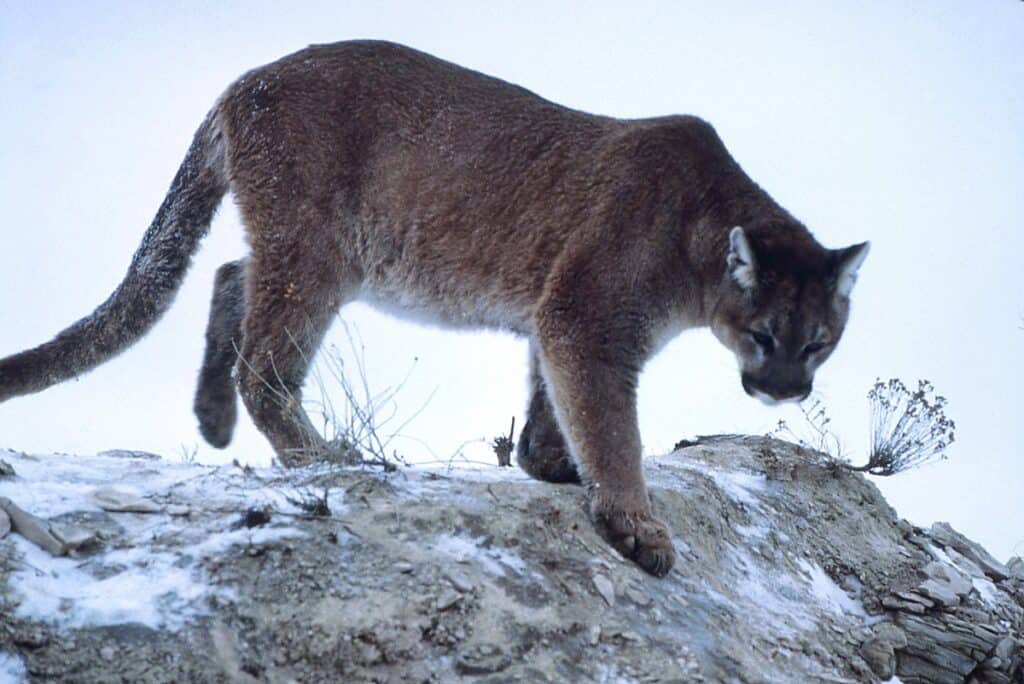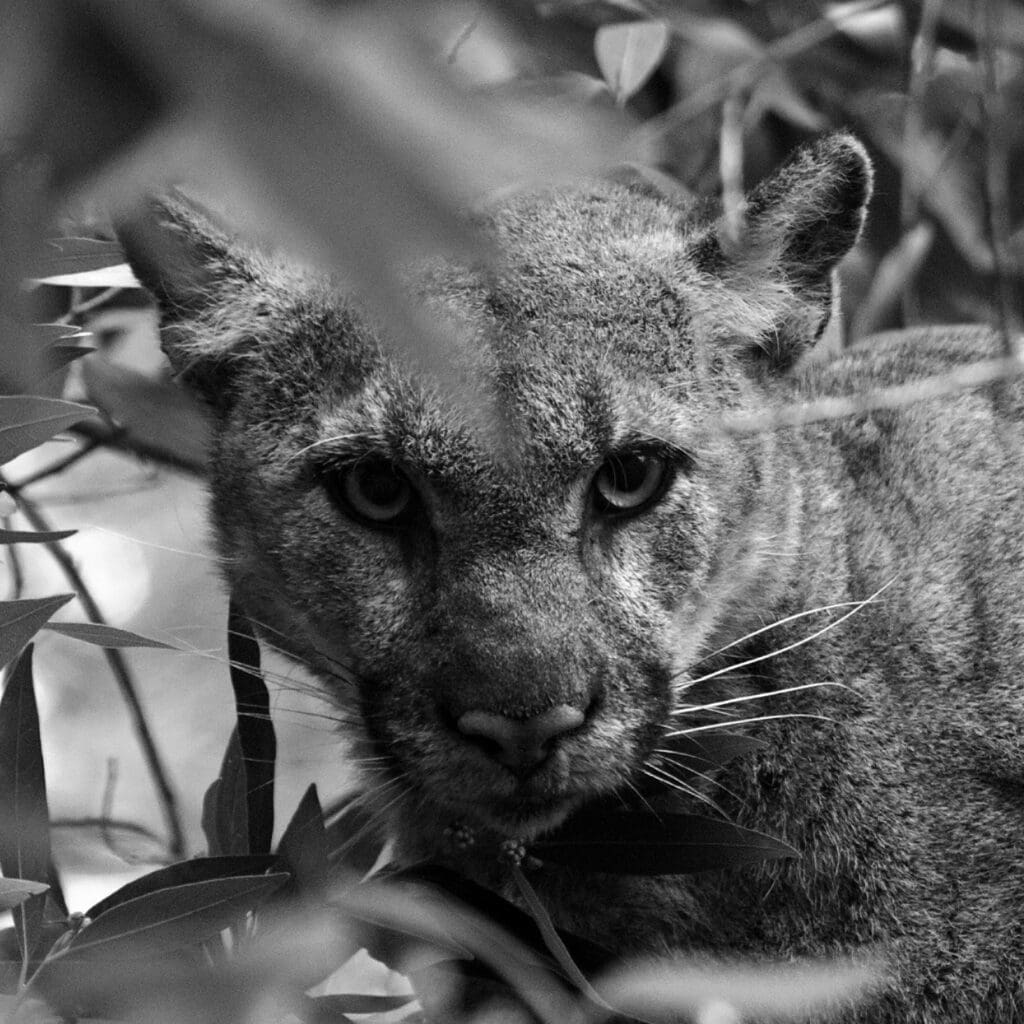Mountain Lions

ECOLOGY OF THE MOUNTAIN LION (Puma concolor)
Evolution
The mountain lion (Puma concolor), also commonly known as the cougar, puma, or catamount, are members of Felidae—the cat family. Surprisingly, they are more closely related to smaller felines, including the domestic cat than to any subspecies of lion (O’Brien & Johnson 2007). The name, puma, is originally derived from the Peruvian Quechua Indians of South America, and means “powerful animal” (Eisenberg 2015).
It was originally believed that 32 subspecies of mountain lions existed, however, genetic analyses in the 1990s revealed that there are only two subspecies of mountain lions in North America: P. c. cougar (much of North America), and P. c. coryi (limited to Florida) (Culver et al. 2000).
The mountain lion is thought to have evolved from a common ancestor with the African cheetah (Miracinonyx trumani) and the American jaguarundi (Herpailurus yagouaroundi) (Culver et al. 2000). Genetic analyses date the origin of mountain lions and its evolution from these common ancestors to the late Miocene (5-8 million years ago) (Culver et al. 2000). Around 2-4 millions years ago, mountain lions arrived in South America during the Great American Interchange–an event where species migrated from North America to South America and vice versa by means of the Panamanian land bridge (Culver et al. 2000). This evidence of movement from North America to South America indicates that modern-day mountain lions originated in North America. However, the fossil record in South America is limited. This prevents the ruling out of a Neotropical origin and northward movement from South America to North America (Culver et al. 2000). Up until the Holocene period (about 12,000 years ago), mountain lions coexisted with other large carnivore felid species such as the American lion (Panthera atrox), North American cheetah (Miracinonyx trumani), and the saber toothed tiger (Smilodon). However, following the Late Pleistocene extinction, mountain lions and jaguars have been the only two large cat species to remain in North America (DeSantis & Haupt 2014).
Distribution and Habitat
Mountain lions have the largest geographic range of any terrestrial mammal in the Western Hemisphere (Nielsen et al., 2015). The range of mountain lions spans from Canada, through the US, and through Central and South America to southern Chile (Nielsen et al. 2015).
While mountain lions are highly adaptable and can be found in every major habitat type of the Americas, their preferred habitats contain ample hiding cover and ungulate prey (Nielsen et al. 2015) rather than open habitats (Gray et al. 2016). Mountain lions employ stalking strategies while hunting, and commonly utilize covered riparian areas and rock ledges for hiding and pouncing (Eisenberg 2015). Generally, they prefer steep mountainous habitats, and coniferous forests, but are also commonly found in lowland tropical forests, grasslands, dry brush country, swamps, and deserts as well (Eisenberg 2015, Gray et al. 2016). Radio-collar data also indicates that mountain lions commonly make use of ecotones (areas where two habitats come together) for stalking (Eisenberg 2015).
Despite the adaptability of this species, mountain lion ranges in the United States have significantly diminished; aside from a small population of Florida panthers (Puma concolor coryi), they were eliminated from the Eastern US by the 1960s (Culvert et al. 2000; McCollough 2011). This decline in their North American range has occurred following the European colonization of North America, and is primarily attributed to unregulated hunting and trapping (Eisenberg 2015; Gill 2010).
Since then, mountain lion numbers in the US have been increasing and since 1990, they have been attempting to disperse into the Midwest (Gantchoff et al. 2021, LaRue et al. 2019). Mountain lions have recolonized the Dakotas and Nebraska, and sightings have been reported in midwestern states such as Wisconsin and Kansas. In fact, in 2011, a mountain lion was found as far east as Connecticut after being killed by a motor vehicle (Eisenberg, 2015). This recent range expansion has also occurred in certain human-dominated regions–especially in the Western US, leading to an increase in sightings in urban and suburban settings (Shivaraju, 2003).

Social Structure
Mountain lions are rather elusive. Because of this, they have generally been described as a solitary species, except during mating periods and juvenile dependence (Shivaraju, 2003; see Elbroch et al. 2016). However, recent research has detailed the rich social repertoire and networks pumas share, along with social interactions characterized by tolerance and reciprocity (Elbroch et al. 2017).
Mountain lions engage in year-round breeding, yet have a relatively low reproductive rate (Eisenberg 2015). Mountain lion mating systems are polygynous, meaning males live and mate with multiple females, but females only mate with a single male. Male mountain lions establish territories that encompass the ranges of several females and attempt to dominate matings with these females (Logan & Sweanor 2001; Shivaraju 2003). When in estrus, females communicate to potential mates with a combination of vocalizations and olfactory cues by rubbing on nearby objects (Eisenberg 2015). The gestation period for mountain lions is roughly 3 months, and mothers typically have an average of three cubs (Eisenberg 2015). In mountain lion mating systems, females have sole parenting duties (Eisenberg 2015), hence the social structure is matrilineal (Logan & Sweanor 2001). After about 40 days, mountain lion cubs are fully weaned, but mothers and cubs stay together for an average of 15 months (Shivaraju 2003). After this period, young males disperse distances up to 274 km, while females can disperse up to 140 km from their mother’s range (Shivaraju 2003).

Appearance
Mountain lions are one of the largest members of the cat family in the Western Hemisphere (Eisenberg 2015). Males weigh between 110-232 pounds, and can grow up to 9.5 ft long from nose to tail tip, and are about 31 inches tall (Eisenberg 2015). Females are smaller in size, averaging about 40% the size of males (Eisenberg 2015).
Their coat is short and coarse, and is generally a yellow brown to gray brown color on their upper body (Shivaraju 2003). Their throat and chest have white fur, while their bellies are a buff color (Shivaraju 2003). This overall tawny color makes mountain lions very cryptic, allowing them to blend into rock outcroppings, deserts, and forest floor debris in their habitats (Eisenberg 2015). Adolescents have paler coats than adults and are covered in dark spots on their flanks that fade after about 2.5 years (Eisenberg 2015). Mountain lions have a distinctive pink nose surrounded by a dark border, accompanied by muzzle stripes. Mountain lions also have short, muscular limbs, long tails, and large feet (Shivaraju 2003).
Diet
Mountain lions are generalists, but are also obligate carnivores, meaning they can only digest meat (Eisenberg 2015). They mainly feed on ungulate species in temperate regions, but also consume smaller mammals such as squirrels, muskrats, porcupines, beavers, bobcats, and other mountain lions that are young or ill (Shivaraju 2003). Mountain lions kill and consume an ungulate about once every 8 days, totaling about 48 ungulates per lion per year (Shivaraju 2003). Female mountain lions have high energetic demands, and have difficulty living in areas without sufficient ungulate prey (Eisenberg 2015). Mountain lion population numbers are closely linked by prey populations; as prey numbers decline, so do mountain lion numbers (Eisenberg 2015). Declines in prey numbers can drive mountain lions to consume domestic ruminants, creating conflicts with humans nearby (Shivaraju 2003; see also Hiller et al. 2015).
When hunting, mountain lions stalk and ambush their prey. They are built for agility and brief bursts of speed rather than high-speed, long-distance chases (Eisenberg, 2015). With their stalking and ambush tactics, mountain lions can kill animals multiple times their size (Eisenberg, 2015). This hunting strategy involves quietly stalking their prey, and then jumping onto their prey’s back and breaking their neck with a bite below the skull (Shivaraju 2003). In addition to this ambush tactic, mountain lions also cache large prey. This means that after killing a large prey, mountain lions will eat some of it and then bury the rest under debris for later consumption (Eisenberg 2015).
ECOLOGICAL ROLE

Mountain lions serve important ecological roles in their communities as apex predators, meaning they exist at the top of their food web, and are not considered prey by other species. As apex predators, mountain lions exert a top-down regulatory influence on these lower trophic levels in what is known as a trophic cascade (LaBarge et al. 2022, Estes et al. 2011, Ripple et al. 2014). For example, mesopredators like foxes and raccoons are typical prey of mountain lions, and these species often rely on bird eggs in their diets. When mountain lions are present, this limits and keeps mesopredator numbers in control, consequently increasing the songbird survival (Eisenberg 2015).
In addition to indirectly supporting songbird survival, mountain lions can also drive trophic cascades which support vegetative communities (Ripple et al. 2014). Because ungulates make up a significant portion of the mountain lion diet, their numbers are reduced and their behavior changes when cougars are present (avoidance mechanisms). Ungulates are browsers, and this reduction in their numbers and change in behaviors promotes tree recruitment and allows for the regeneration of over-browsed vegetation. They also influence processes affecting aquatic species such as amphibians, by, for example, contributing to stabilizing stream banks (Ripple et al. 2014).
Aside from their top-down trophic regulation, mountain lions influence their ecosystems through food subsidies. Because mountain lions cache their kills, species like bears and vultures are able to scavenge and feed off of these remains (Eisenberg 2015).
Finally, mountain lions are considered to be ‘focal’ (or umbrella) species because they require so much habitat that conserving them will inadvertently benefit multiple other species. Because mountain lions have large ranges and require areas with low human density, protections for mountain lion habitat will benefit other species that share the space.
THREATS TO COUGARS
The International Union for the Conservation of Nature currently lists mountain lions as of least concern, but with a decreasing population trend (Nielsen et al., 2015). However, the IUCN recognizes that declines may be occurring in the Western Hemisphere and that there are ambiguities regarding population trends for this species based on region. Researchers currently believe that there may now be more mountain lions than there were before the European settlement of the US (Eisenberg 2015; Knopp et al. 2014). This could be attributed to the management of ungulate prey at high levels, and additional prey availability due to increases in ranching (Eisenberg, 2015). While mountain lion populations have been expanding their ranges and increasing population numbers in some areas, they face a suite of diverse threats challenging their recovery.
Habitat fragmentation is currently the single largest threat to mountain lion conservation (Eisenberg, 2015). Mountain lions have large ranges and the dispersal of males is vital for gene flow and the prevention of intraspecific competition (Eisenberg 2015). The Allee effect and the edge effect are two factors of fragmented landscapes that make dispersal difficult for mountain lions. The allee effect occurs when males disperse into areas where mountain lion densities are too low to find mates, while the edge effect limits dispersal due to poor habitat surrounding local populations (Eisenberg 2015). Road infrastructure is also exacerbating the threat of habitat fragmentation and is a significant barrier to dispersal (Shivaraju 2003). Freeways almost completely block movement of mountain lions, and this prevention of dispersal can jeopardize the fate of small, isolated populations (Shivaraju 2003). In the Florida Panther subpopulation, collisions on roadways are the primary cause of mountain lion mortality (Nielsen et al. 2015).
In addition to habitat fragmentation, mountain lions are also greatly threatened by hunting pressures (Suraci et al. 2019, Wilmers et al. 2021). By the mid-1970s, bounty hunting of mountain lions was eliminated (Eisenberg 2015). Since then, mountain lion populations have been managed through sport hunting in the United States (Eisenberg 2015; Laundré & Papouchis 2020). Mountain lions are freely hunted in Mexico and Canada, but this practice is banned in much of Latin America (Eisenberg 2015). When hunting mountain lions, humans tend to kill the animals considered ‘trophies’; i.e., large adult males (Eisenberg 2015). The hunting of adult males can disrupt the stability of the mountain lion’s social structure, and this can cause increased juvenile immigration from nearby populations (Maletzke et al. 2014; Robinson et al. 2008). Research demonstrates that younger mountain lions are more likely to occur in human-dominated areas, and this can exacerbate conflicts with humans (Logan & Sweanor 2001; Cooley et al. 2009; Peebles et al. 2013; Teichman et al. 2016). Moreover, such demographic changes may increase incidences of infanticide through the immigration of new and unrelated males, which also force females with kittens onto suboptimal habitat to avoid them, and cause declines in the female puma population (Cooley et al 2009; Keehner et al. 2015; Peebles et al. 2013)
TIPS AND TOOLS FOR COEXISTENCE
Because this species is so elusive, however, there is a lack of well-documented examples of human-mountain lion coexistence (Eisenberg 2015). Despite an increased range expansion of mountain lions in North America and an increase in reported sightings of this species, conflicts between humans and mountain lions are rare, and coexistence with this species is certainly possible.
Between the 1970s and the 1990s, cougar attacks on humans increased fivefold, but this is attributed to human development encroaching on previously high-quality cougar habitat (Eisenberg 2015). These attacks usually involve small children or individuals traveling alone, and researchers believe that these attacks occur because mountain lions mistake humans for their usual ungulate prey (Shivaraju 2003). In order to prevent these attacks, and consequent human retaliation on this species, it is advisable to be cautious of your surroundings when in mountain lion habitats. Specifically, it is advisable to wear bright, contrasting clothing (this prevents mountain lions from mistaking you for ungulate prey), make your presence known with vocalizations or whistles, keep children nearby, or take a large dog with you (Seleshanko, 2021).
Another source of conflicts between humans and mountain lions occurs when mountain lions prey on domesticated ruminant animals (e.g., cows, sheep). The issue of habitat fragmentation and local decreases in their prey numbers pushes these mountain lions to kill domestic ruminants. However, these threats to domestic animals are sometimes exaggerated (Nielsen et al., 2015; Shivaraju, 2003), and may be a result of human-caused mortality (Peebles et al. 2013). These instances of domestic ruminant predation can result in retaliatory hunting by humans, but a number of ranching techniques can help prevent and mitigate these occurrences. For instance, ranchers can use guard dogs to deter these predators from coming near their animals. The removal of domestic animal carcasses on ranches can also prevent mountain lions from being drawn to areas with ruminants. It is also advisable to keep small animals in covered, sheltered areas, and to keep grasses short so that mountain lions do not use this as a cover for ambush (Seleshanko, 2021). Light deterrents have also been shown to discourage pumas from preying on domesticated animals (see Ohrens et al. 2019).
Finally, because of the threat that road infrastructure poses to large carnivore conservation, the construction of wildlife barriers and safe roadway crossings can help facilitate mountain lion dispersal while preventing deaths from vehicle collisions. A recent case study looking at the effect of mountain lion recolonization using deer-vehicle collisions suggests cougars can reduce deer densities next to roads, substantially reducing deer-vehicle collisions, thousands of injuries, hundreds of lives and billions of dollars in avoided costs (Gilbert et al. 2017). Such benefits, coupled with the ecosystem effects of cougars, should be considered when estimating the benefits of coexistence
LITERATURE CITED
WildFutures. (n.d.). Coexisting with Mountain Lions. Retrieved September 13, 2022, from https://www.wildfutures.us/coexistence.html
Cooley, H. S., R. B. Wielgus, H. S. Robinson, G. Koehler, and B. T. Maletzke. (2009). Does hunting regulate cougar populations: a test of the compensatory mortality hypothesis. Ecology 90:2913–2921.
Culver, M., Johnson, W. E., Pecon-Slattery, J., & O’brien, S. J. (2000). Genomic ancestry of the American puma (Puma concolor). Journal of Heredity, 91(3), 186–197.
DeSantis, L. R., & Haupt, R. J. (2014). Cougars’ key to survival through the late pleistocene extinction: Insights from dental microwear texture analysis. Biology Letters, 10(4).
Eisenberg, C. (2015). Cougar (Puma concolor). In The carnivore way: Coexisting with and conserving North America’s Predators (pp. 191–217). essay, Island Press.
Elbroch, M. L., Levy, M., Lubell, M., Quigley, H., & Caragiulo, A. (2017). Adaptive social strategies in a solitary carnivore. Science Advances, 3(10).
Estes JA, Terborgh J, Brashares JS, Power ME, Berger J, Bond WJ et al. (2011) Trophic downgrading of planet earth. Science 333: 301– 306.
Gilbert, S. L., Sivy, K. J., Pozzanghera, C. B., DuBour, A., Overduijn, K., Smith, M. M., Zhou, J., Little, J. M., & Prugh, L. R. (2017). Socioeconomic Benefits of Large Carnivore Recolonization Through Reduced Wildlife-Vehicle Collisions. Conservation Letters, 10(4), 430–438. https://doi.org/10.1111/conl.12280
Gill, R.B. (2010) “To save a mountain lion: evolving philosophy of nature and cougars,” in Cougar Ecology and Conservation (Ed Mornocker M and Negri S). pp 5–16. University of Chicago Press
Gray, M., Wilmers, C. C., Reed, S. E., & Merenlender, A. M. (2016). Landscape feature-based permeability models relate to puma occurrence. Landscape and Urban Planning, 147, 50–58. https://doi.org/10.1016/j.landurbplan.2015.11.009
Hiller, T. L., McFadden-Hiller, J. E., Jenkins, S. R., Belant, J. L., & Tyre, A. J. (2015). Demography, prey abundance, and management affect number of cougar mortalities associated with livestock conflicts. Journal of Wildlife Management, 79(6), 978-988. doi:10.1002/jwmg.913
Keehner, J. R., Wielgus, R. B., & Keehner, A. M. (2015). Effects of male targeted harvest regimes on prey switching by female mountain lions: Implications for apparent competition on declining secondary prey. Biological Conservation, 192, 101–108.
Knopff KH, Webb NF, Boyce MS (2014) Cougar population status and range expansion in Alberta during 1991– 2010. Wildl Soc Bull 38:116–121
LaBarge, L. R., Evans, M. J., Miller, J. R. B., Cannataro, G., Hunt, C., & Elbroch, L. M. (2022). Pumas Puma concolor as ecological brokers: a review of their biotic relationships. Mammal Review, 1–17.
LaRue MA, Nielsen CK, Pease BS (2019) Increases in Midwestern cougars despite harvest in a source population. J Wildl Manage 83:1306–1313
Laundré, J. W., & Papouchis, C. (2020). The Elephant in the room: What can we learn from California regarding the use of sport hunting of pumas (Puma concolor) as a management tool? PLoS ONE, 15(2), 1–26.
Logan, K.A. & Sweanor, L.L. (2001) Desert Puma: Evolutionary Ecology and Conservation of an Enduring Carnivore. Island Press, Washington, DC, USA.
Maletzke, B. T., Wielgus, R., Koehler, G. M., Swanson, M., Cooley, H., & Alldredge, J. R. (2014). Effects of hunting on cougar spatial organization. Ecology and Evolution, 4(11), 2178–2185. https://doi.org/10.1002/ece3.1089
McCollough, M. (2011). Eastern puma (cougar)(Puma concolor couguar) 5-year review: summary and evaluation. U.S. Fish and Wildlife Service. 110p.
Nielsen, C., Thompson, D., Kelly, M. & Lopez-Gonzalez, C.A. 2015. Puma concolor (errata version published in 2016). The IUCN Red List of Threatened Species 2015: e.T18868A97216466. https://dx.doi.org/10.2305/IUCN.UK.2015-4.RLTS.T18868A50663436.en. Accessed on 07 September 2022.
O’Brien, S. J., & Johnson, W. E. (2007). The evolution of cats. Genomic paw prints in the DNA of the world’s wild cats have clarified the cat family tree and uncovered several remarkable migrations in their past. Scientific American, 297(1), 68–75.
Ohrens, O., Bonacic, C., & Treves, A. (2019). Non-lethal defense of livestock against predators : flashing lights deter puma attacks in Chile. Frontiers in Ecology and the Environment, 1–7.
Peebles, K. A., Wielgus, R. B., Maletzke, B. T., & Swanson, M. E. (2013). Effects of remedial sport hunting on cougar complaints and livestock depredations. PLoS One, 8(11), e79713.
Ripple, W. J., Estes, J. A., Beschta, R. L., Wilmers, C. C., Ritchie, E. G., Hebblewhite, M., Berger, J., Elmhagen, B., Letnic, M., Nelson, M. P., Schmitz, O. J., Smith, D. W., Wallach, A. D., & Wirsing, A. J. (2014). Status and ecological effects of the world’s largest carnivores. Science, 343(6167), 1241484.
Seleshanko, K. (2021, March 14). Coexisting with Cougars. Mountain Lion Foundation. Retrieved September 13, 2022, from https://mountainlion.org/2020/10/02/coexisting-with-cougars/#:~:text=Ideally%2C%20locate%20pastures%20away%20from,chain%20pets%20or%20livestock%20outside
Shivaraju, A. 2003. “Puma concolor” (On-line), Animal Diversity Web. Accessed September 07, 2022 at https://animaldiversity.org/accounts/Puma_concolor/
Suraci, J. P., Clinchy, M., Zanette, L. Y., & Wilmers, C. C. (2019). Fear of humans as apex predators has landscape-scale impacts from mountain lions to mice. Ecology Letters, 22(10), 1578–1586. https://doi.org/10.1111/ele.13344
Teichman, K. J., Cristescu, B., & Darimont, C. T. (2016). Hunting as a management tool? cougar-human conflict is positively related to trophy hunting. BMC Ecology, 16(1). https://doi.org/10.1186/s12898-016-0098-4
Wilmers, C. C., Nisi, A. C., & Ranc, N. (2021). COVID-19 suppression of human mobility releases mountain lions from a landscape of fear. Current Biology, 31(17), 3952-3955.e3. https://doi.org/10.1016/j.cub.2021.06.050

